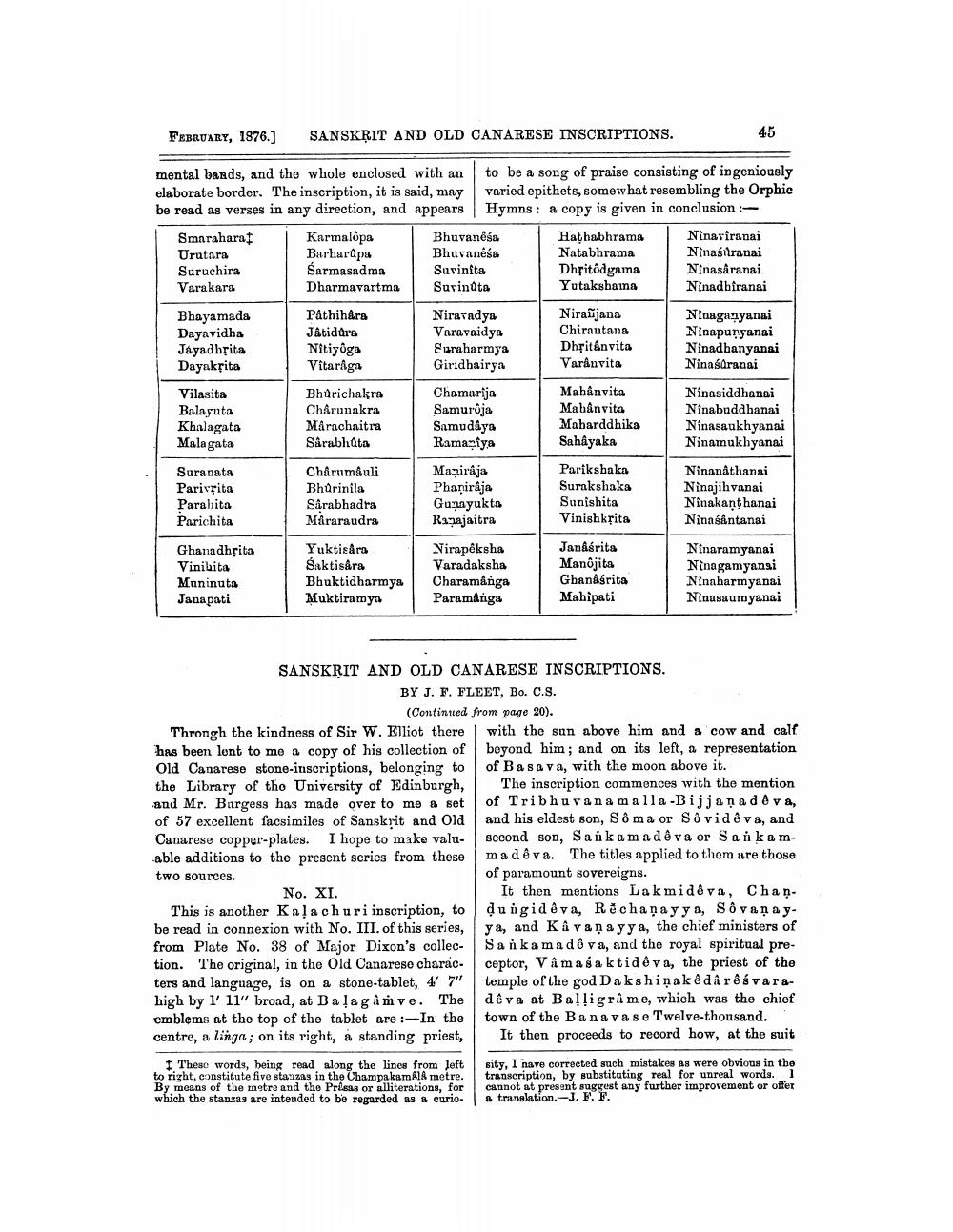________________
FEBRUARY, 1876.]
SANSKRIT AND OLD CANARESE INSCRIPTIONS.
45
mental bands, and the whole enclosed with an to be a song of praise consisting of ingeniously elaborate border. The inscription, it is said, may varied epithets, somewhat resembling the Orphic be read as verses in any direction, and appears Hymns: a copy is given in conclusion :Smaraharat Karmalopa Bhuvanesa
Hathabhrama Ninaviranai Uratara Barharapa Bhuvanesa
Natabhrama Ninastranai Suruchira Sarmasadma Suvinita
Dhritôdgama Ninasaranai Varakara Dharmavartma Surinta
Yutakshama Ninadbiranai Bhayamada Pathihara
Niraradys Nirajana
Ninaganyanai Dayavidha J&tidura
Varavaidya Chirantana Ninapuryanai Jayadhsita Nitiyoga
Surabarmya Dhşit&nvita
Ninadbanyansi Dayaksita Vitaraga Giridhairya Varânvita
Ninasaranai Vilasita Bhurichakra Chamarija
Mahânvita
Ninasiddhanai Balaguta Charunakra Samuroja
Mahânvita Ninabuddhanai Khalagata Marachaitra Samudaya
Maharddhika Ninasaukhyanai Malagata Sarabhata Ramaiya Sahayaka
Ninamukhyanai Suranata Charumauli Maziraja
Pariksbaka Ninanathanai Parivrita Bhůrinila Phaniraja
Surakshaka Ninajihvanai Parahita Sarabhadra Gunayukta Sunishita
Ninakanthanai Parichita Máraraudra Ranajaitra
Vinishkrita
Ninasantanai
Ghanadhfita Vinibita Muninuta Janapati
Yuktisara Saktisara Bhuktidharmya Muktiramya
Nirapeksha Varadaksha Charamanga Paramanga
Janåsrita Manôjita Ghanåsrita Mahipati
Ninaramyanai Ninagamyansi Ninnharmyanai Ninasaumyanai
SANSKRIT AND OLD CANARESE INSCRIPTIONS.
BY J. F. FLEET, Bo. C.S.
(Continued from page 20). Through the kindness of Sir W. Elliot there with the sun above him and a cow and calf has been lont to me a copy of his collection of beyond him; and on its left, a representation Old Canarese stone-inscriptions, belonging to of Basava, with the moon above it. the Library of tho University of Edinburgh, The inscription commences with the mention and Mr. Bargess has made over to me a set of Tribhuvanamalla-Bijja nad êva, of 57 excellent facsimiles of Sanskrit and Old and his eldest son, S ôma or Sovidê va, and Canarese copper-plates. I hope to make valu- second son, Saika madê va or Sa i ka mable additions to the present series from these mad êva. The titles applied to them are those two sources.
of paramount sovereigns. No. XI.
It then mentions Lakmidê va, Chan. This is another Kala churi inscription, to dungidêva, Rē chaņay ya, Sôvaņaybe read in connexion with No. III. of this series, ya, and Kû vaņayya, the chief ministers of from Plate No. 38 of Major Dixon's collec- Sankamad 8 va, and the royal spiritual pretion. The original, in the Old Canarese charac- ceptor, Vâmasaktide va, the priest of the ters and language, is on a stone-tablet, 4' 7" temple of the god Dakshinak & dar & svarahigh by l' 11" broad, at B alagamve. The dê va at Balligrame, which was the chief emblems at tho top of the tablet are: In the town of the Bana vas e Twelve-thousand. centre, a linga; on its right, å standing priest, It then proceeds to record how, at the suit
These words, being read along the lines from left to right, constitute five stanzas in the Champakamala metre. By means of the metro and the Prisas or alliterations, for which the stanzas are intended to be regarded as & curio
sity, I have corrected such mistakes as were obvious in the transcription, by substituting real for unreal words. ] cannot at present suggest any further improvement or offer & translation.-J.FF.




